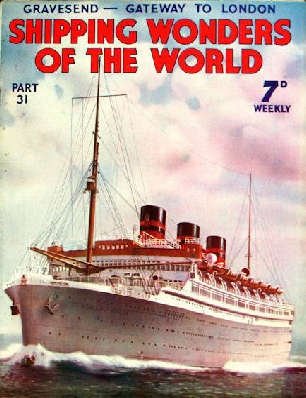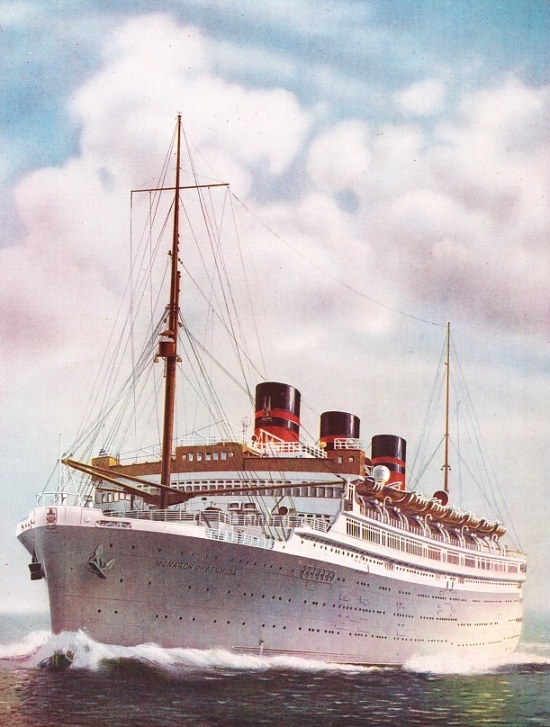
© Shipping Wonders of the World 2012-



Part 31
Part 31 of Shipping Wonders of the World was published on Tuesday 8th September 1936.
This issue included a colour plate illustrating the Monarch of Bermuda, which formed part of the article on the Bermudian Luxury Liners. The plate was attached to page 973 of part 31.
The Cover
This week’s cover shows the Monarch of Bermuda, described, with her sister ship, the Queen of Bermuda, in a chapter in this week’s Part. The original photograph, from which this cover was made, was obtained through the courtesy of Vickers-Armstrongs , the builders of the great luxury liners. The cover was also reproduced as the colour plate in this issue.

Contents of Part 31
Drake and the Golden Hind
The story of Francis Drake and the Golden Hind, concluded from part 30.
Bermudian Luxury Liners
The Monarch of Bermuda and the Queen of Bermuda are two large British liners that run regularly between New York and Bermuda. This special service has definite characteristics which govern the design of luxury liners for the run. Bermuda has long been a popular holiday resort among Americans, particularly in the days of Prohibition. To deal with this holiday traffic, the Furness-Withy Line built first the Bermuda, later destroyed by fire, then two all-electric ships, the Monarch of Bermuda and a sister ship, the Queen of Bermuda. This chapter describes the accommodation of the two vessels, and gives full details of the engineering and mechanical aspects of the ships.
This the eighth article in the series on The World’s Largest Ships.
The Monarch of Bermuda (colour plate)
Contents of Part 31 (continued)
Heroism and Disaster at Sea
In the long history of the sea, there have, of course, been some failures as well as many glorious successes, some tales of disaster besides those stories of ships with which all has gone well. But even in the tragedies there is something inspiring. The extraordinary sinking of HMS Victoria in 1893 in the Mediterranean and the loss of the troopship Birkenhead off Danger Point, near Simon’s Bay, South Africa, on February 26, 1852, will long be remembered for the heroism that these catastrophes called forth. These stories are some of the epics of the sea.
The Royal Marines
Formerly the fighting in warships was done by soldiers specially embarked for that purpose. The modern Royal Marine Corps is one of the most striking links with those days of early maritime warfare.
This chapter is the fourth article in the series Going to Sea.
Japanese Inland Sea Passenger Ship
A description of the Kurenai Maru, one of the first ships built for the Japanese Inland Sea to be fitted with diesel engines. Completed in July 1924, she is owned by the Osaka Shosen Kaisha Company, whose big cargo liners are familiar on the trade routes of the world. She is a ship with three decks.
This is the twenty-third article in the series on Merchant Ship Types.
How Yachts are Raced
The regulations and rules, international, national and local, which govern yacht racing have undergone considerable changes in the last thirty years. Many conditions make yacht races difficult for the layman to follow. One reason for this is the system of handicapping, which often makes it difficult for those not conversant with the rules to tell which boat has won.
Gravesend - Gateway to London
Situated on the Kentish shore of the River Thames opposite Tilbury, Gravesend is one of the main bases of river and Channel pilots, of Customs and immigration officers and of the Port of London Sanitary Authority. From time immemorial, Gravesend has been regarded as the gateway to London. In the times of the Viking raiders, Gravesend was one of the key points of defence and from then on it was always kept fortified. In the Middle Ages many brilliant ceremonies and pageants were to be seen there when important personages arrived from abroad. Nowadays the pomp and pageantry are gone. But Gravesend is still the gateway of London.
Pidgeon and the Islander
The first man to sail on a single-handed voyage of World circumnavigation since Captain Joshua Slocum’s exploit in 1895-98. Harry Pidgeon left Los Angeles in the Islander on November 18, 1921. His voyage lasted for nearly four years.
This chapter is the sixth article in the series Great Voyages in Little Ships. The article is concluded in part 32.
